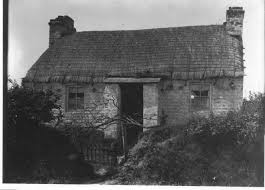
Family history research is one of my winter hobbies. In summer it gets squeezed out by gardening, walking and other outside pursuits.
In pursuit of my husband's Manx ancestors last night, I came across the following:
In 1714 the Vicar, Matthias Curghey, inserted in the register " a receipt to cure the biteing of a mad dog. Take the leaves of rue pick’d from the stalks and bruise six ounces; garlick pick’d from the stalks and bruised, fetche four ounces; boil all these over a slow fire, in two quarts of strong ale, till one pint be consumed ; then keep it in a. bottle close stopt and give of it, nine spoonfulls to a man or woman warm, seven mornings together, fasting, and six to a dog.. This the author believes will not (by God’s blessing) : fail if it be given within nine days of the biteing of the dog. Apply some of the ingredients from which the liquor was strained to the bitten place. N.B. This receipt was taken out of Calthorp Church in Lincolnshire, where many in the town were bitten with a mad dog, and all that took the medicine did well and the rest died mad. The same receipt is hung up in Bradford Church in Wiltshire, where its efficacy had been approved on the like occasion."
I rather like the bit which says "all that took the medicine did well and the rest died mad." Hmmm!
My husband's ancestors were poor and lived thus:
Thick as the cottages are, they do not strike the eye; the walls of the huts are seldom above seven feet high, composed generally of sods of earth', and the roofs thatched with straw, which soon becomes of a murky hue. This straw is bound down with straw-ropes drawn over net-like, and fastened to pegs in the walls; this mode of thatching requires often to be renewed.
"The lower class of inhabitants live on meal of oats and barley, and fish and potatoes, with a small portion of flesh meat. Their breakfast is of meal pottage and milk; their dinner is of potatoes and fish; their supper pottage, or potatoes and milk."*Their bread is made of barley and oatmeal, and is formed into very thin round cakes like pancakes.
Taken from the Isle of Man FHS site.


5 comments:
Hi Jennie, not sure which rue it was, but I used to grow the blue/grey leafed one as a background plant. The only problem was that if you broke a stem, a milky white sap would run out, which caused quite a bad rash. To rue the day, wonder where that came from...
I'll make sure to save these instructions for the next time I encounter a mad dog! LOL! My dog gets mad if I don't let her sleep in the house every day, wonder if that will cure her! Hee Hee!
Blessings
Linda
My late mother-in-law, who had trained as an RN, also was a beleiver in herbal remedies. She used garlic both internally and externally as a cleansing/healing agent. I shouldn't think rue could be taken internally, but as a topical astringent? We take general cleanliness so for granted today!
Minion - think externally would have been better than internally with the Rue, for the reasons that Thelma gave. It's like the spurges in that way. Hopefully I will never get bitten by a mad dog and have to try it!
the remedy sounds pretty potent. sounds like the story has been well documented. what a strange mixture of herbs. Wonder how they ever came up with it.
Post a Comment